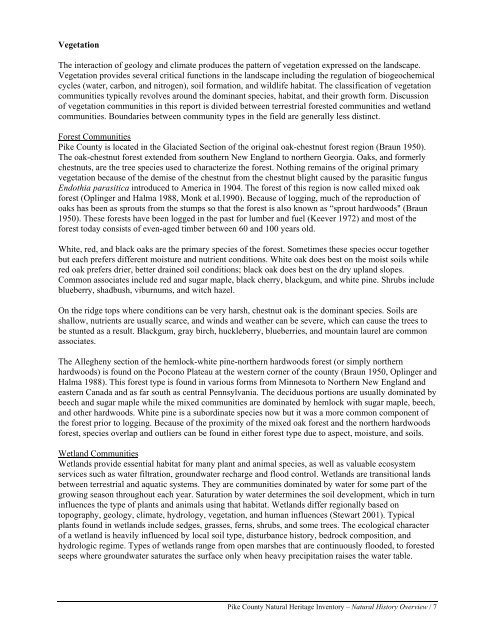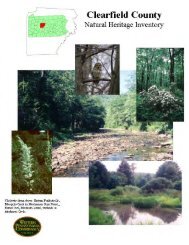Pike CNHI - Pennsylvania Natural Heritage Program
Pike CNHI - Pennsylvania Natural Heritage Program
Pike CNHI - Pennsylvania Natural Heritage Program
You also want an ePaper? Increase the reach of your titles
YUMPU automatically turns print PDFs into web optimized ePapers that Google loves.
Vegetation<br />
The interaction of geology and climate produces the pattern of vegetation expressed on the landscape.<br />
Vegetation provides several critical functions in the landscape including the regulation of biogeochemical<br />
cycles (water, carbon, and nitrogen), soil formation, and wildlife habitat. The classification of vegetation<br />
communities typically revolves around the dominant species, habitat, and their growth form. Discussion<br />
of vegetation communities in this report is divided between terrestrial forested communities and wetland<br />
communities. Boundaries between community types in the field are generally less distinct.<br />
Forest Communities<br />
<strong>Pike</strong> County is located in the Glaciated Section of the original oak-chestnut forest region (Braun 1950).<br />
The oak-chestnut forest extended from southern New England to northern Georgia. Oaks, and formerly<br />
chestnuts, are the tree species used to characterize the forest. Nothing remains of the original primary<br />
vegetation because of the demise of the chestnut from the chestnut blight caused by the parasitic fungus<br />
Endothia parasitica introduced to America in 1904. The forest of this region is now called mixed oak<br />
forest (Oplinger and Halma 1988, Monk et al.1990). Because of logging, much of the reproduction of<br />
oaks has been as sprouts from the stumps so that the forest is also known as “sprout hardwoods" (Braun<br />
1950). These forests have been logged in the past for lumber and fuel (Keever 1972) and most of the<br />
forest today consists of even-aged timber between 60 and 100 years old.<br />
White, red, and black oaks are the primary species of the forest. Sometimes these species occur together<br />
but each prefers different moisture and nutrient conditions. White oak does best on the moist soils while<br />
red oak prefers drier, better drained soil conditions; black oak does best on the dry upland slopes.<br />
Common associates include red and sugar maple, black cherry, blackgum, and white pine. Shrubs include<br />
blueberry, shadbush, viburnums, and witch hazel.<br />
On the ridge tops where conditions can be very harsh, chestnut oak is the dominant species. Soils are<br />
shallow, nutrients are usually scarce, and winds and weather can be severe, which can cause the trees to<br />
be stunted as a result. Blackgum, gray birch, huckleberry, blueberries, and mountain laurel are common<br />
associates.<br />
The Allegheny section of the hemlock-white pine-northern hardwoods forest (or simply northern<br />
hardwoods) is found on the Pocono Plateau at the western corner of the county (Braun 1950, Oplinger and<br />
Halma 1988). This forest type is found in various forms from Minnesota to Northern New England and<br />
eastern Canada and as far south as central <strong>Pennsylvania</strong>. The deciduous portions are usually dominated by<br />
beech and sugar maple while the mixed communities are dominated by hemlock with sugar maple, beech,<br />
and other hardwoods. White pine is a subordinate species now but it was a more common component of<br />
the forest prior to logging. Because of the proximity of the mixed oak forest and the northern hardwoods<br />
forest, species overlap and outliers can be found in either forest type due to aspect, moisture, and soils.<br />
Wetland Communities<br />
Wetlands provide essential habitat for many plant and animal species, as well as valuable ecosystem<br />
services such as water filtration, groundwater recharge and flood control. Wetlands are transitional lands<br />
between terrestrial and aquatic systems. They are communities dominated by water for some part of the<br />
growing season throughout each year. Saturation by water determines the soil development, which in turn<br />
influences the type of plants and animals using that habitat. Wetlands differ regionally based on<br />
topography, geology, climate, hydrology, vegetation, and human influences (Stewart 2001). Typical<br />
plants found in wetlands include sedges, grasses, ferns, shrubs, and some trees. The ecological character<br />
of a wetland is heavily influenced by local soil type, disturbance history, bedrock composition, and<br />
hydrologic regime. Types of wetlands range from open marshes that are continuously flooded, to forested<br />
seeps where groundwater saturates the surface only when heavy precipitation raises the water table.<br />
<strong>Pike</strong> County <strong>Natural</strong> <strong>Heritage</strong> Inventory – <strong>Natural</strong> History Overview / 7










